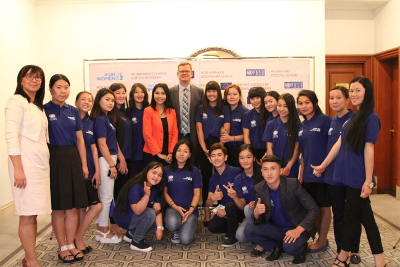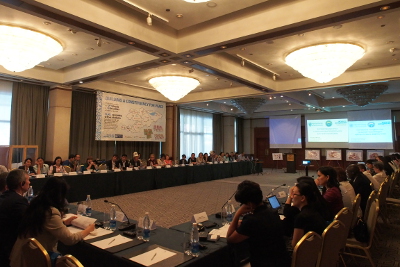Peace project in Kyrgyzstan teaches respect for rights and diversity
A UN Women project funded by the UN Peace and Recovery Facility has raised awareness about gender-based violence, respect for rights and diversity, and the importance of local conflict analysis in KyrgyzstanDate:

Thousands of students across the Kyrgyzstan gained an understanding of life skills, problem solving, respect for diversity, and human rights under the UN Women’s Building a Constituency for Peace Project, funded under the United Nations Peace and Recovery Facility.
Results of the wide-ranging initiative were shared at an event in Bishkek to mark the International Day of Peace.
The project has worked to promote gender equality by involving women, especially young women, in all aspects of public life and economic activity, and by building support systems to ensure their rights, particularly those related to living a life free of violence. It focused on bridging ethnic divisions by promoting equal opportunity regardless of ethnic origin, by facilitating practical livelihood skills and by building knowledge on how to be a good citizen.
Ainuru Altybaeva, Member of Parliament in the Kyrgyzstan said, “The project supported excellent workshops to raise awareness on issues like gender-based violence, bride kidnapping, and marriages with minors.“

Under the component of the project called “My Safe and Peaceful School”, more than 2,099 secondary school students in 60 schools learned about human rights of young women and men, as well as gender equality. They studied how to conduct a conflict analysis and take action to address the causes, working with law enforcement, and local self-government institutions.
"The course gave us exactly the right information and life skills to face problems and find ways to overcome them,” said Mr. Argen Shergazi Uulu, peer educator.
The students learned how to secure rights for themselves and their peers. The project gave them the tools to actively participate in community affairs and help solve problems affecting their schools and communities. One underlying thesis of the programme is that girls are somewhat less likely to be victims of violence when they can make informed choices regarding their well-being.

"UN Women is one of the most active organizations working with young people. It is a great achievement that the project reached such a large number of schools, teachers and students,” said Mr. Alexander Avanessov, UN Resident Coordinator in the Kyrgyzstan.
In addition, roughly 3,800 secondary school students in 33 schools completed the "My Prosperous Farm” course where they learned to use limited land resources for productive agricultural activities in a market economy. They constructed 43 low-cost greenhouses with cost-sharing from their own funds and project support.
"Student participation in the project has broadened their horizons, communication skills, and confidence. They are now aware of their rights and know about gender equality,” said Ms. Elmira Kerimalieva, National Consultant on Evaluation of this project.
More than 500 representatives of government agencies and civil society were also sensitized to human rights of young women and men, including religious rights. The project helped make them more aware of the duties of state and municipal servants to protect human rights and how to conduct a conflict analysis of their community.